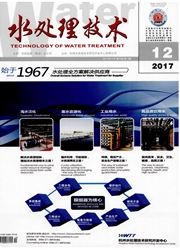

 中文摘要:
中文摘要:
分以产甲烷颗粒污泥为接种污泥,在UASB反应器实现了甲烷化耦合反硝化厌氧氨氧化。采用荧光定量PCR(QPCR)和荧光原位杂交(FISH)技术分析了耦合过程中关键营养菌群的绝对数量、相对丰富度和空间分布的变化。UASB反应器运行250 d后,NO2--N、NO3--N、NH4+-N和COD的去除率分别为99.99%、99.99%、48%和75%;细菌、产甲烷菌、反硝化菌、厌氧氨氧化菌/亚硝酸盐还原酶基因(nir S,nir K)和N2O还原酶基因(nos Z)的相对丰富度分别为89.2%、10.8%、11.7%、0.964%、(9.52%,0.902%)和1.22%。耦合过程中,形成了具有明显分层结构的甲烷化耦合反硝化厌氧氨氧化颗粒污泥(外层细菌,内部古细菌)。
 英文摘要:
英文摘要:
Methanogenesis, denitrification and anaerobic ammonium oxidation were integrated in a UASB reactor with the methanogenic granule sludge as inoculation sludge. A combination of quantitative PCR (QPCR) and fluorescence in situ hybridization (FISH) technique were used to analyze the changes of absolute quantity, relative abundance and spatial distribution of Key Microbial Trophic Groups in integrating process. Aider 250 days of operation, the remove rate of NO2--N, NO3--N, NH4+-N and COD was 99.99%, 99.99%, 48% and 75%, respectively. The relative abundances of bacteria, methanogens, denitrificans, anammox bacteria/nitrite reductase gene (nirS, nirK) and N20 reductase gene (nosZ) were 89.2%, 10.8%, 11.7%, 0.964%, (9.52% and 0.902%) and 1.22%, respectively. In the process of integration, formation of anaerobic granular sludge (AGS) with an obvious multi-layer architecture was also observed (bacteria on the exterior of AGS, archaea in the interior).
 同期刊论文项目
同期刊论文项目
 同项目期刊论文
同项目期刊论文
 期刊信息
期刊信息
